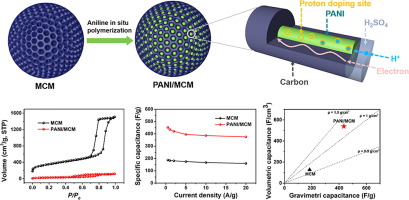当前位置:
X-MOL 学术
›
J. Colloid Interface Sci.
›
论文详情
Our official English website, www.x-mol.net, welcomes your
feedback! (Note: you will need to create a separate account there.)
Construction of mesoporous carbon microsphere/polyaniline composites as high performance pseudocapacitive electrodes.
Journal of Colloid and Interface Science ( IF 9.4 ) Pub Date : 2020-03-24 , DOI: 10.1016/j.jcis.2020.03.085 Gaojia Mu 1 , Cheng Ma 2 , Xiaojun Liu 1 , Wenming Qiao 2 , Jitong Wang 2 , Licheng Ling 2
Journal of Colloid and Interface Science ( IF 9.4 ) Pub Date : 2020-03-24 , DOI: 10.1016/j.jcis.2020.03.085 Gaojia Mu 1 , Cheng Ma 2 , Xiaojun Liu 1 , Wenming Qiao 2 , Jitong Wang 2 , Licheng Ling 2
Affiliation

|
Mesoporous carbon microspheres (MCMs), as a supercapacitor electrode material, have good gravimetric capacitance and rate performance; however, their low volumetric capacitance, which results from their low density, restricts their application as a micro power source. Herein, polyaniline was introduced into the channels of MCMs to achieve a synergistic effect and significantly increase the volumetric capacitance. MCMs with a high surface area and pore volume allowed the uniform dispersion of PANI within their channels in nanoscale dimensions. The interconnected carbon framework could provide excellent electrical conductivity and alleviate the structural collapse of PANI. Moreover, PANI could function not only as an active pseudocapacitive material that facilitated energy storage but also as a proton transport media that promoted a rapid protonation/deprotonation process during the redox reaction in the internal channels. As a result, PANI/MCM composites, even with a poor pore structure, delivered a high volumetric capacitance of 539F cm-3 at 1 A g-1 and an excellent rate performance of 83% at current densities ranging from 0.5 to 20 A g-1. In addition, PANI/MCM composites exhibited good cycling stability, retaining 84% of the capacitance after 1000 charge/discharge cycles at 1 A g-1, owing to the high mechanical strength of the MCMs. Therefore, this synthesis strategy could provide an efficient and scalable solution for the development of supercapacitor electrode materials.
中文翻译:

介孔碳微球/聚苯胺复合材料作为高性能假电容电极的构建。
介孔碳微球(MCM)作为超级电容器电极材料,具有良好的重量电容和倍率性能;然而,由于其低密度而导致的低体积电容限制了其作为微电源的应用。在此,将聚苯胺引入MCM的通道中以达到协同作用并显着增加体积电容。具有高表面积和孔体积的MCM允许PANI以纳米级尺寸在其通道内均匀分散。互连的碳骨架可提供出色的导电性,并减轻PANI的结构破坏。此外,PANI不仅可以充当促进能量存储的活性拟电容材料,而且还可以充当质子传输介质,在内部通道的氧化还原反应过程中促进快速的质子化/去质子化过程。结果,即使孔结构较差,PANI / MCM复合材料在1 A g-1时仍具有539F cm-3的高体积电容,在0.5至20 A g的电流密度下也具有83%的优异倍率性能-1。此外,由于MCM的高机械强度,PANI / MCM复合材料表现出良好的循环稳定性,在1 A g-1下进行1000次充电/放电循环后仍保留84%的电容。因此,该合成策略可以为超级电容器电极材料的开发提供有效且可扩展的解决方案。
更新日期:2020-03-26
中文翻译:

介孔碳微球/聚苯胺复合材料作为高性能假电容电极的构建。
介孔碳微球(MCM)作为超级电容器电极材料,具有良好的重量电容和倍率性能;然而,由于其低密度而导致的低体积电容限制了其作为微电源的应用。在此,将聚苯胺引入MCM的通道中以达到协同作用并显着增加体积电容。具有高表面积和孔体积的MCM允许PANI以纳米级尺寸在其通道内均匀分散。互连的碳骨架可提供出色的导电性,并减轻PANI的结构破坏。此外,PANI不仅可以充当促进能量存储的活性拟电容材料,而且还可以充当质子传输介质,在内部通道的氧化还原反应过程中促进快速的质子化/去质子化过程。结果,即使孔结构较差,PANI / MCM复合材料在1 A g-1时仍具有539F cm-3的高体积电容,在0.5至20 A g的电流密度下也具有83%的优异倍率性能-1。此外,由于MCM的高机械强度,PANI / MCM复合材料表现出良好的循环稳定性,在1 A g-1下进行1000次充电/放电循环后仍保留84%的电容。因此,该合成策略可以为超级电容器电极材料的开发提供有效且可扩展的解决方案。











































 京公网安备 11010802027423号
京公网安备 11010802027423号